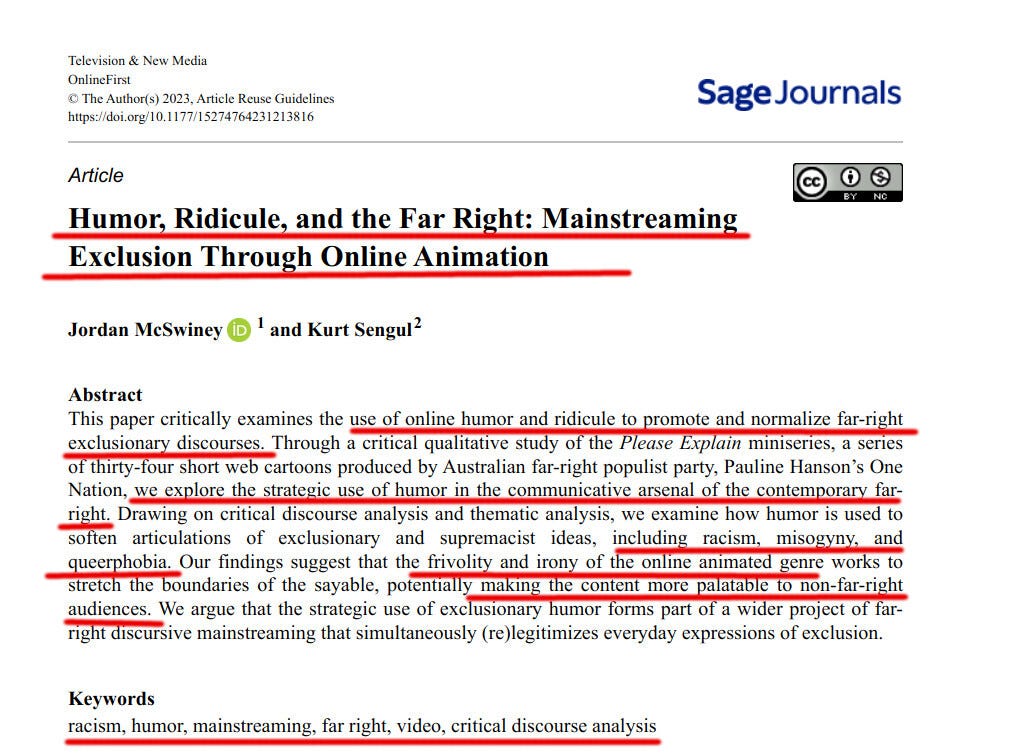Dear Readers: I am sorry for sprinkling humor and sarcasm throughout my Substack posts. My apologies!
Had I known that Australian social scientists Jordan McSwiney and Kurt Sengul found the use of humor and ridicule to be an insidious attack on our democracy, I would certainly avoid even a trace of sarcasm or humor in my articles!
According to the authors, the evil far-right forces invented a novel, innovative, and subversive discursive technique called humor.
It is broadly accepted that contemporary far-right actors, be they parties, movements, or activists, are savvy media performers (Wodak 2021) who employ a range of innovative communication strategies to exploit the highly mediatized and hybridized political landscape. A particular focus in recent times has been the effective use of humor and irony as part of the far-right’s social media strategy (Greene 2019).
Humor is used insidiously:
Humor and laughter have powerful social functions. Through sharing a joke, humor can positively impact social cohesion, by generating feelings of enjoyment through shared laughter. [very dangerous for democracy – I.C.] It engenders group cohesion and solidarity in a manner that is fun and playful. As a form of affective rhetoric, humor can persuade or align, facilitating social cooperation by uniting interlocutors.
We are beginning to see how dangerous humor is because laughter can keep social groups together, which is totally unacceptable. The authors go on, being utterly serious and bordering on the pompous:
But humor can also be used to divide and marginalize, constructing and maintaining social distance and inequalities. In the form of ridicule, humor serves to “target, discipline, marginalize, and alienate groups and individuals who are othered”. Humor can therefore be both pro- and anti-social: one can “laugh with others and at others”. In doing so, humor may simultaneously foster greater social affiliation with the in-group and greater social distance against out-groups, and so plays an active role in boundary maintenance. Through negative portrayals of the Other, casting them as buffoonish, dangerous, inferior, and the like, exclusionary humor reproduces and normalizes social hierarchies. Such joking works to support exclusionary notions and structures regardless of the intention of the joke teller. In a settler-colonial society such as Australia, where historic and ongoing inequalities stem from systematic racial and gender hierarchies, exclusionary humor along such lines naturalizes these unequal social relations.
Humor, it turns out, makes materials more accessible to neutral audiences:
Here, humor helps the far right to soften their ideological content, deactivating social boundaries and making their materials more palpable to non-far-right audiences
The McSwiney et al. article turns its attention to a series of cartoons named Please Explain by an Australian politician, Pauline Hanson.
According to the article’s authors, these cartoons illustrate why “far-right humor” is such a social danger.
According to the party, the aim of the series was to “deliver a humorous yet sobering glimpse into the Australian political arena”. Pitched as a “satirical, animated series that was partly educational, and a whole lot of fun”, Please Explain was designed to appeal to younger and politically disengaged voters, and draws on South Park, which it mimics in style and tone.
The authors accuse these cartoons of promoting bigotry and xenophobia in their pseudoscientific, gobbledygook language.
Our findings suggest that the Please Explain online animated series serves as a humorous way to disseminate highly ideological and exclusionary far-right populist content. Through our thematic analysis and multimodal discourse analysis, we found that exclusionary and supremacist discourses manifested multimodally throughout the series, making effective use of the online animation genre.
I have viewed exactly one such video and shared it with my readers when I discussed The Voice, a conspiratorial attempt to push through a vague constitutional amendment to the Constitution of Australia. The proposal would create an unaccountable and unelected constitutional body that would be manipulated through shadowy “democracy committees.”
In no small part, The Voice was defeated because of this funny YouTube video, which I highly recommend watching and which I referred to in my post above:
Please watch the above cartoon. You will see that it ridicules the liars who deceived the Australian public about the referendum proposal – it does not in any way laugh, exclude, or make fun of Native Australians.
To the crazed political hacks McSwiney and Sengul, anything that lampoons their pet projects is far-right, exclusionary content that seeks to marginalize vulnerable groups.
The Voice referendum failed resoundingly: over 60% of Australians voted against it.
To McSwiney and Sengul, this failure represents the victory of the “exclusionary far-right” (to which 60.1% of Australians apparently belong).
Their article boringly drones on and on about “exclusionary utterances and visuals.“ You would hope that a discussion of humor would include at least one funny sentence from the authors, but you’d be disappointed: McSwiney and Sengul are deadly serious and supremely boring throughout.
The authors conclude:
… humor helps the far right to extend the boundaries of the sayable (Wodak 2021), working to normalize discourses generally frowned upon in Australian political discourse. Further, the strategic use of humor also helps the far right to present racism, misogyny, and anti-LGBTIQA+ politics as “a joke,” and topics appropriate to joke about. This, we suggest, makes humor a powerful tool in the communicative arsenal of the contemporary far right and the advancement of their supremacist political project.
Lastly, these political hacks, to whom everything oppositional is extreme right-wing, exclusionary and supremacist, declare “no competing interests.” Take a look at Jordan McSwiney’s profile:
Does that look like a profile of someone with “no competing interests”?
I propose this inclusive and democratic poll:
Is humor a danger to our democracy? If not, what is? Please share your thoughts in the comments section!
Humor is a Threat to Our Democracy, Australian Political Scientists Claim (igor-chudov.com)
 RSS Feed
RSS Feed















 December 1st, 2023
December 1st, 2023  Awake Goy
Awake Goy 




 Posted in
Posted in  Tags:
Tags: 













